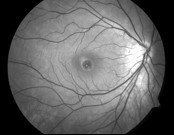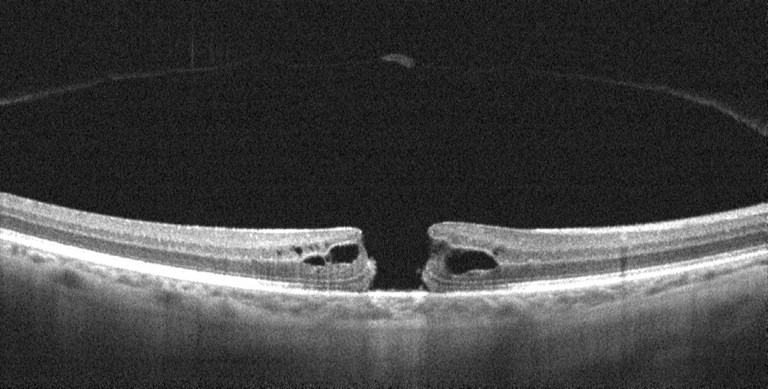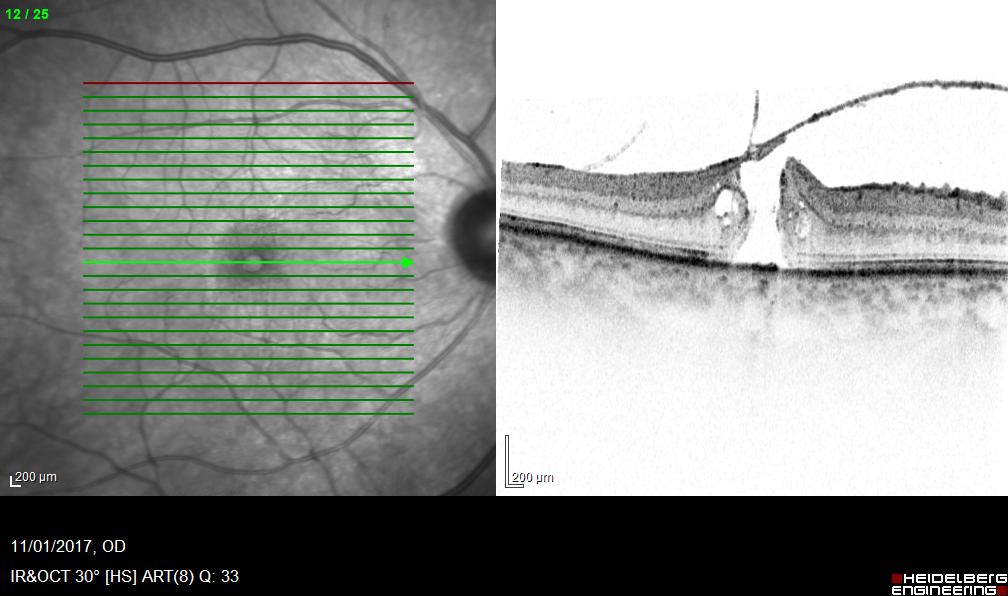Macular Hole
A macular hole is a retinal problem whereby a hole develops in the macular region. The macula is the part of the eye that gives you your central vision. A macular hole therefore causes distortion in the central vision and sometimes a dark spot is noticed in the centre of the vision. The underlying cause is thought to be due to a fine membrane around the macula which undergoes outwards traction which pulls the hole open. This is something that happens with age, and is not related to genetics, diet, exercise or due to anything you have done to your eye.
What can be done to treat a Macular Hole?
Modern surgery is now very successful in closing the macular hole and improving vision. Surgery involves vitreoretinal microsurgery where very fine microsurgical instruments are inserted inside the eye and the vitreous jelly removed. The membrane which causes the macular hole is also removed. A special gas bubble is left in the eye which is absorbed over two to four weeks and replaced with the eye’s own natural fluids. The success rate of closure of a standard macular hole is 99 %. Rare atypical, long standing or post-traumatic holes may require further surgery if the initial surgery is not successful in closing the hole.
Very rarely some holes, particularly those holes which have been present for a long period of time, may not be able to be closed.
What is the chance of my vision improving?
What will happen if I do not have the surgery?
If the hole is not treated it will almost always cause further deterioration in vision and enlarge with time leaving a larger size dark spot in the centre of vision. Some very small, partially developed macular holes may close spontaneously without treatment and these are therefore simply observed. This will require regular follow-up by your eye doctor. Spontaneous closure is rare however, less than 1% for a Stage 3 hole. Once the macular hole begins to enlarge and your vision decreases, the chance of spontaneous closure is extremely low, and surgery should be considered to close the hole.
What are the possible risks?
Though macular hole surgery is successful in closing most macular holes, one should be aware that all surgery has risk, and occasionally there are problems which can arise following the surgery.
- A cataract may develop earlier than would be expected during the normal aging process, although we all develop cataracts with age and modern cataract surgery is a very quick and successful surgery.
- Occasionally, the eye may develop increased pressure (glaucoma) and medication may be required to control this.
- Retinal tears or detachment of the retina may develop during surgery, or following surgery, and may require further surgery to correct these.
- Infection and haemorrhage are very rare risks which may occur with any surgery. If you notice pain or reduced vision following surgery, our consulting rooms should be contacted on 3831 0101 as soon as possible. Infections are often treatable if detected early. A severe infection or severe bleeding however can result in permanent blindness, but this is very rare, much less than 1 %.
- When considering surgery, one should be aware of an approximate 10% risk of the other eye developing the same problem. One would be severely impaired if both eyes should develop a macular hole. Surgery is usually successful in closing the hole, stabilising further deterioration in vision and improving the vision.
What will happen after the surgery?
Following surgery, the vision will be blurred for approximately two to four weeks, due to the gas bubble and the dilating eye drops. As the bubble gets smaller with time, you will see a black, wobbly, horizontal line which will slowly become lower and lower. This is the edge of the gas bubble, and is normal.
For the first 24 hours following surgery you need to keep your face down with your nose parallel to the floor for at least 50-55 minutes in the hour, the other 5-10 minutes may be used to perform normal duties. You need to sleep with your head face down as much as possible. The face down position can be maintained whilst sitting in a chair and keeping one’s head down or if this isn’t possible you may lie on your side with your nose facing over the edge of the bed down to the ground. You must not sleep on your back while the gas bubble is in your eye.
Immediately after the surgery, a patch will be placed on your eye with tape. This will be removed the morning after the surgery by the nurse or surgical assistant. Following this, there is no need to wear a patch during the day. A protective shield is recommended for sleeping, for the first few days after the surgery
Eye drops
Eye drops need to be used for one to two months following surgery. These should commence the day after surgery, after your have seen your surgeon.
Glasses
New spectacles may need to be obtained a few months following surgery.
Intraocular Gas
It is extremely important to understand the following warnings about an intraocular gas bubble:
- While the bubble is present, you MUST NOT FLY in an airplane under any circumstances. Doing so could result in blindness as the bubble expands with altitude. If you have air travel plans within the first two months after your surgery, mention this to your doctor.
- If you need to travel over the range to Toowoomba, you must discuss this with your doctor first. The increased altitude can cause severe, vision threatening pressure rises. It is usually best to stay at sea level for 1 week before going back over the range. This depends on the type of bubble, so ask your doctor.
- If you require surgery of any kind over the following two months you MUST TELL THE ANAESTHETIST ABOUT THE GAS BUBBLE, as nitrous gas anaesthetics will cause the bubble to expand and cause severe vision threatening pressure rises. This includes dental procedures.
Face down positioning aids
These are not essential, and most patients do not need them, however for those with back or neck problems, this equipment can be useful. There are companies that hire out equipment to help you maintain the face down posture reducing the strain on your neck and back.
More information
There is a lot of information available on the internet. It is very important however to ensure that the information comes from a reputable source. Unfortunately there are websites with false or misleading information, or websites offering unproven or potentially dangerous treatments. It is strongly recommended to visit only reputable government or university websites.
The following websites are from the world’s leading hospitals or government sponsored reputable research institutions, and the information is of high quality.
The Royal National Institute of the Blind
Harvard Medical School – Digital Journal of Ophthalmology
Harvard Medical School – Digital Journal of Ophthalmology



